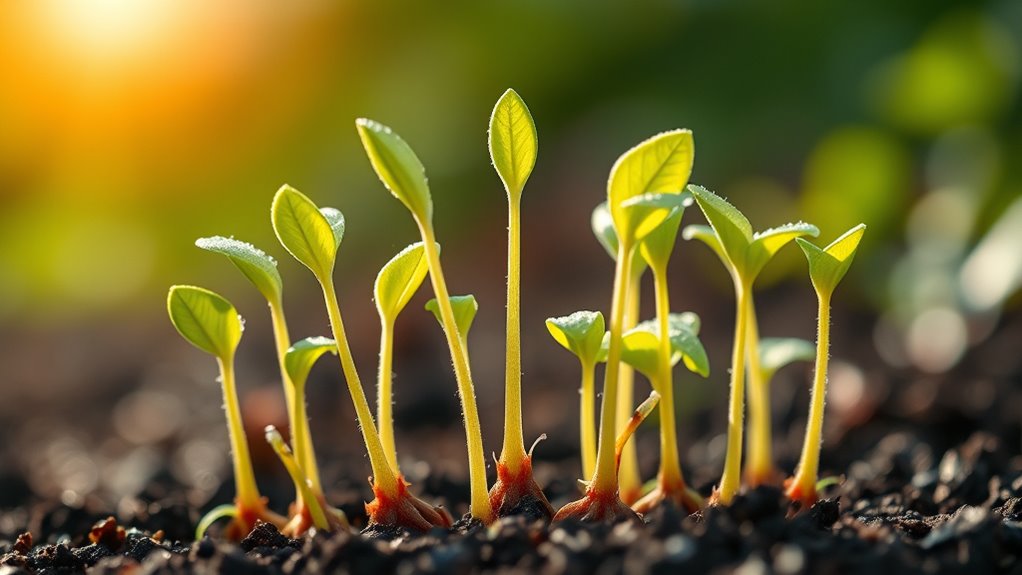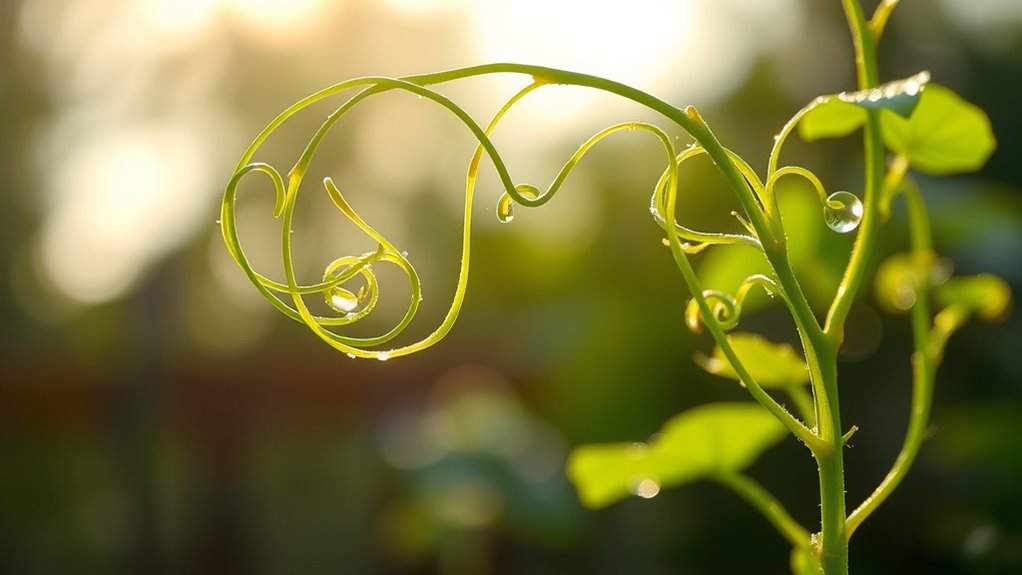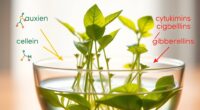Plants sense gravity through specialized cells in their roots containing starch-filled organelles called amyloplasts that act as statoliths. These settle under gravity, triggering hormonal responses, mainly involving auxin, which redistributes unevenly. This uneven auxin causes roots to grow downward and shoots to grow upward, defying gravity for ideal survival. If you want to understand how plants fine-tune this complex process and adapt their growth, there’s more to discover below.
Key Takeaways
- Plants use specialized cells with starch-filled amyloplasts to sense gravity direction.
- Amyloplasts settle under gravity, triggering hormonal responses that guide growth.
- Auxin hormone redistributes unevenly, promoting cell elongation on specific sides of roots and shoots.
- Roots grow downward into soil, while shoots grow upward toward sunlight, despite gravity.
- This internal signaling system enables plants to orient themselves correctly and adapt to their environment.

Have you ever wondered how plants grow from tiny seeds into lush, thriving organisms? It’s a fascinating process, especially when you consider how they manage to grow upward toward the light and downward into the soil, despite gravity’s pull. This remarkable ability hinges on a complex system known as plant hormone signaling, which controls root directional growth and overall plant orientation. When a seed germinates, it begins sensing its environment almost immediately, detecting gravity’s influence and adjusting its growth accordingly. This sensing isn’t passive; it involves a series of biochemical signals that tell the plant which way is up and which way is down.
At the heart of this process is a plant hormone called auxin. When a seedling is placed in the soil, auxin concentrates on the side of the root that’s facing downward. This uneven distribution of auxin promotes cell elongation on one side and inhibits it on the other, causing the root to bend downward—a process called positive gravitropism. Conversely, in the shoot, auxin redistributes differently, promoting upward growth despite gravity’s pull. This dynamic redistribution is a key part of plant hormone signaling that allows roots to grow downward and shoots upward, effectively defying gravity’s influence.
Auxin redistributes to promote downward root growth and upward shoot growth, enabling plants to defy gravity.
Your plants are constantly interpreting gravity signals through specialized cells in the root cap. These cells contain starch-filled organelles called amyloplasts, which act as statoliths—settling under gravity and signaling the plant’s internal machinery to adjust growth direction. When amyloplasts settle, they trigger a cascade of hormonal responses, especially involving auxin. The hormone moves to specific areas, guiding cell growth and elongation in a way that ensures roots grow downward into the soil for stability and access to nutrients, while shoots stretch upward toward the sunlight for photosynthesis.
This ability isn’t just about growth; it’s an elegant example of how plants use internal signaling to adapt to their environment. By sensing gravity and responding through plant hormone signaling pathways, they position their roots deep in the soil and their leaves high in the air. Interestingly, recent research shows that the integration of robotics in agriculture could enhance our understanding and support of these natural processes. It’s a finely tuned system that ensures survival, allowing plants to thrive in diverse environments. So, next time you see a seedling sprout and grow, remember that it’s not just random growth—it’s a carefully orchestrated response to gravity, driven by plant hormone signaling and precise root directional growth that defies what seems impossible.
Frequently Asked Questions
How Do Plants Detect Gravity at the Cellular Level?
You can think of plants detecting gravity through cell signaling and organelle dynamics. When gravity pulls on plant cells, specialized structures called statoliths (starch-filled organelles) settle, triggering signals that tell the plant which way is down. These signals influence the movement of organelles like the cytoskeleton, helping the plant adjust growth. This process allows plants to orient themselves correctly, ensuring roots grow downward and shoots upward.
What Role Do Plant Hormones Play in Gravity Sensing?
Plant hormones, especially auxin, play a vital role in gravity sensing through hormonal signaling and auxin distribution. When you tilt a plant, auxin redistributes to the lower side of the stem or root, promoting cell elongation or division accordingly. This uneven auxin distribution guides the plant to grow upward or downward, allowing it to adapt to gravity. Your plant fundamentally uses hormonal signaling to reorient itself in response to gravitational cues.
Can Plants Grow Normally in Zero-Gravity Environments?
In zero gravity, you’ll find that plants struggle to grow normally because gravity influence on seed germination is absent. Without gravity, plant mechanoreceptors can’t detect up or down, disrupting their usual growth patterns. This makes roots and shoots grow randomly rather than in coordinated directions. Researchers are exploring ways to simulate gravity or use mechanical signals to help plants adapt, but their growth remains quite different from Earth’s natural conditions.
How Do Root and Shoot Responses Differ in Gravity Perception?
Imagine roots as your plant’s underground compass and shoots as its skyward travelers. Root responses rely on gravity perception mechanisms like statoliths settling in root cap cells, guiding downward growth. Shoots, however, use different cues, like light and auxin distribution, to grow upward. While roots sense gravity directly, shoots integrate multiple signals, making their responses distinct but equally crucial for the plant’s orientation and survival.
Are There Genetic Differences in Gravity Sensitivity Among Plant Species?
You’ll find that genetic variability influences how plant species respond to gravity, with some showing heightened sensitivity and others less so. Different species have evolved distinct gravity response mechanisms, which affect root and shoot orientation. These genetic differences mean that certain plants can adapt more effectively to their environments, optimizing growth and stability. Understanding these variations helps breeders select species suited for specific conditions, enhancing agricultural success and plant resilience.
Conclusion
As you walk through a garden, imagine the silent dance of roots digging deep and stems reaching high, all guided by an unseen force. Plants sense gravity like an instinctual whisper, steering them toward stability and light. Their growth is a quiet symphony of balance and purpose, reminding you that even in stillness, there’s a powerful story of adaptation. Just as plants find their way, you too can navigate life’s challenges with resilience and grace.










